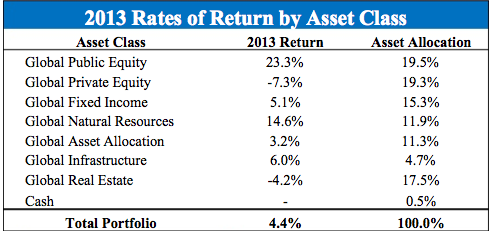The Dallas Police and Fire Pension Fund (DPFPF) knew 2013 wasn’t going to be a great year for investment returns. They knew this because 2012 wasn’t a great year, and neither were the five years prior.
Even as numerous funds across the country have struggled with maintaining strong investment returns over that period, the DPFPF was performing worse than most.
Bad investment results are what led to the June firing of top administrator Richard Tettamant. Still, the fund had hoped a 13 percent return was in the cards for 2013—not an overly impressive number, given the S&P 500 had returned around 25 percent over the same period.
But that didn’t come to fruition. DPFPF’s return data was released this month, and the fund posted a grim 4.4 percent return for 2013, failing to meet its lofty 8.5 percent assumed rate of return.
What makes DPFPF different from other funds? For one, asset allocation.
According to the Center for Retirement Research, the average public pension fund allocates around 49 percent of its investments to equities, 7 percent to real estate and 27 percent to fixed-income strategies.
The DPFPF, on the other hand, invests significantly less in equities and bonds and significantly more in real estate. Its real estate investments did not do well.
Nor did its private equity investments. The fund says 45 percent of its private equity allocation is placed in two investments: Huff Energy and Red Consolidated Holdings.
Red Consolidated Holdings was flat on the year. But Huff Energy returned a negative 29.7 percent for 2013, which brought down the entire private equity portfolio.
This year isn’t an anomaly for the DPFPF. The fund has consistently under-performed its peers. From Dallas News:
Over the past five years, it has earned an annual return of 8.6 percent, according to preliminary figures from its consultant. That placed it 97th among about 100 similar-size funds, the consultant reported. The median annual return during that period was 12.2 percent.
In 2012, the fund earned 11.4 percent on its investments. The median annual return for similar funds was 12.2 percent.
The fund’s investment staff received big bonuses in 2013 nonetheless. That’s because the bonuses aren’t determined by how the fund performs relative to its peers. Instead, staff receive bonuses if investment performance beats the assumed rate of return.
Since the assumed rate of return for the DPFPF sits at 8.5 percent, the 2012 investment performance (11.4%) triggered the bonuses even though the fund under-performed relative to its peers.
Tettamant’s base salary in 2012 was $270,000, and he received over $100,000 in bonuses between 2012 and 2013.
Photo by Taylor Bennett via Flickr CC License

